GETTING SERIOUS
Matches, spouses, and soulmates%
Married in NYC
%
Single in NYC
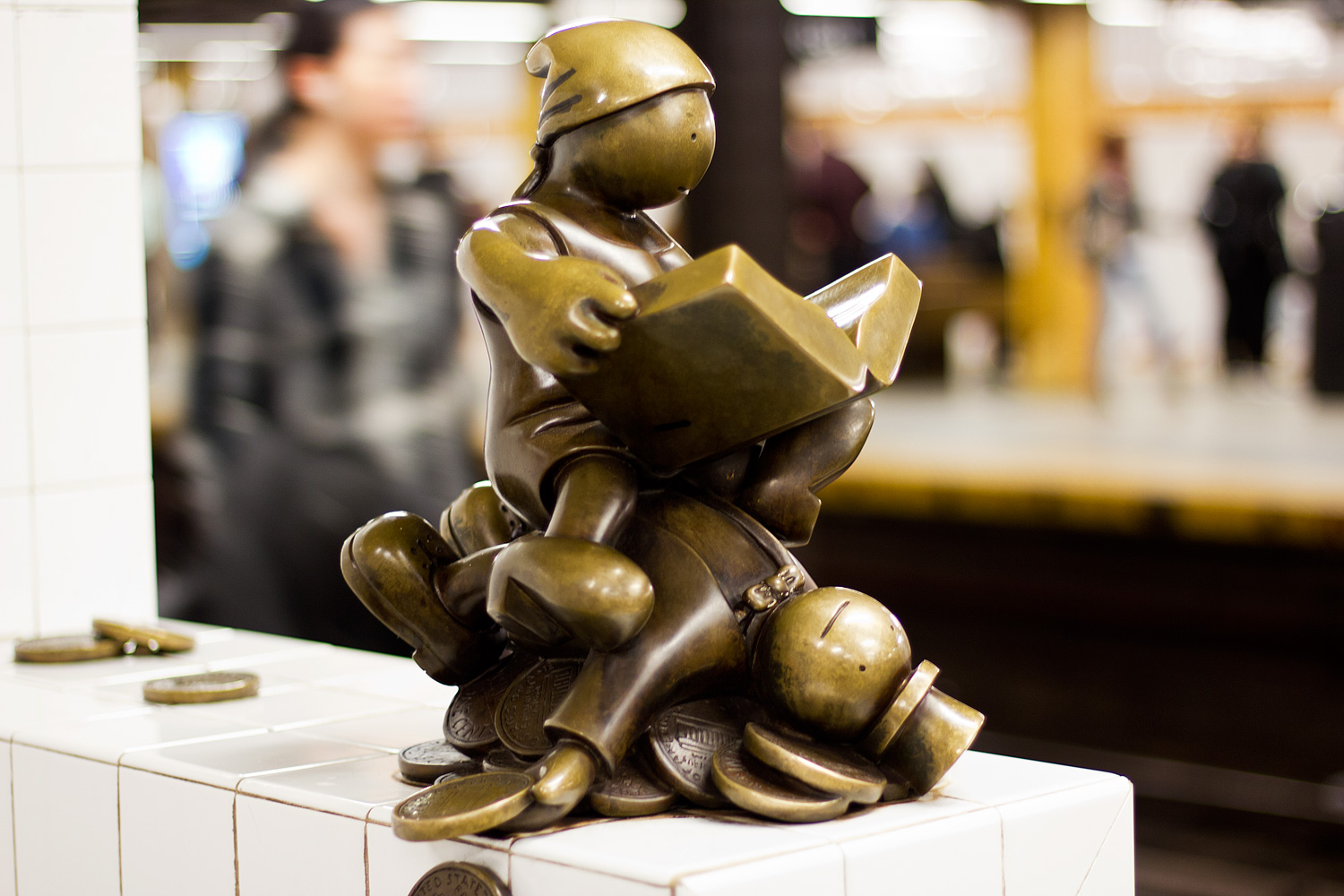
Matchmaker, Matchmaker, Make Me a Match
Finding a romantic partner in New York City can be complicated. For a hefty price, matchmakers can simplify the process.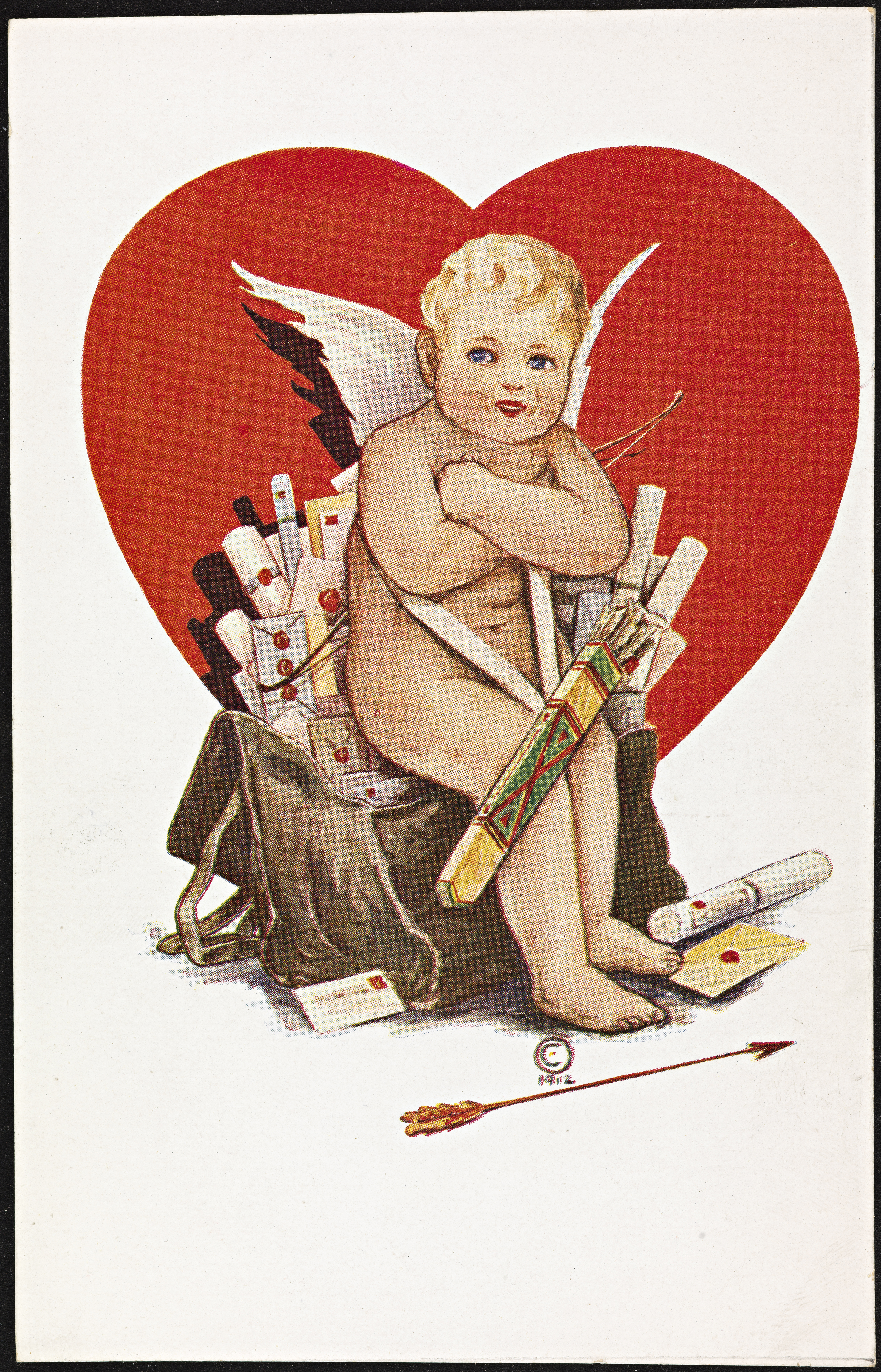
Matchmakers consider themselves to be modern-day cupids. (Courtesy of the National Library of Norway)
by Courtney Vinopal
On a Wednesday evening, in a din meeting room in the basement of a Wells Fargo across from Grand Central Station, dozens of women are gathered to hear Maria Avgitdis, the CEO of Agape Match, speak about chemistry — not as it relates to particles and atoms, but rather as it relates to finding and maintaining a compatible relationship. Translation: it’s okay to someone who your parents will approve of, but be open to other possibilities, too.
Since Avgitidis, a Greek American, started her matchmaking business in 2008, her team has set up clients on over 1,000 first dates. The women who showed up to the panel, which was sponsored by the Hellenic Professional Women’s Society, were mostly either middle-aged or Millenials, and most of them were of Greek origin. They spoke in hushed whispers to each other before the talk began and filled out questionnaires about their preferences in a relationship. “I know that everyone’s filling out their forms, but please remember to get something to eat,” urged one of the organizers. But food wasn’t on most of their minds. Instead they were hoping Avgitidis would find them the perfect mate.
Once the women started talking with one another, stories of dates gone wrong flowed easily. “I liked him so much, and after the second date my phone was about to explode he was texting me,” said one women. “But then he was late to dinner. After that, no chemistry at all.” Others felt conflicted about dating guys who had been divorced, or were disappointed by misleading photos on dating profiles.
“It’s exactly like gossip, that’s what kind of lured me in,” said Chrisolou Maurianos, Avgitidis’s sister, who joined the business in 2015.
For Avgitidis, matchmaking is a family tradition. Back on a small island called Alonissos, both her mother and grandmother were matchmakers. “This was back when people met through the community,” said Avgitidis, noting that her family would get paid for their services with goods like cows or chickens. Fast-forward a few generations, and Avgitidis is continuing this family tradition in New York, charging $15,000 for six months of her matchmaking services. For women who are looking to settle down, Avgitidis said that it is well worth the price.
While matchmaking may be one of the oldest methods of courtship in the books, it remains a thriving business today, and not just in ethnic communities. A report from Statista indicates that the number of people in the United States using matchmaking services is expected to reach 152.4 million by 2021. The United States is the number one market for matchmaking, followed by China and Germany, with a volume of $774 million in 2017. Even as the dating market becomes ever saturated with free apps that promise instant gratification to users, consumers seeking romance remain drawn to the matchmaking experience.
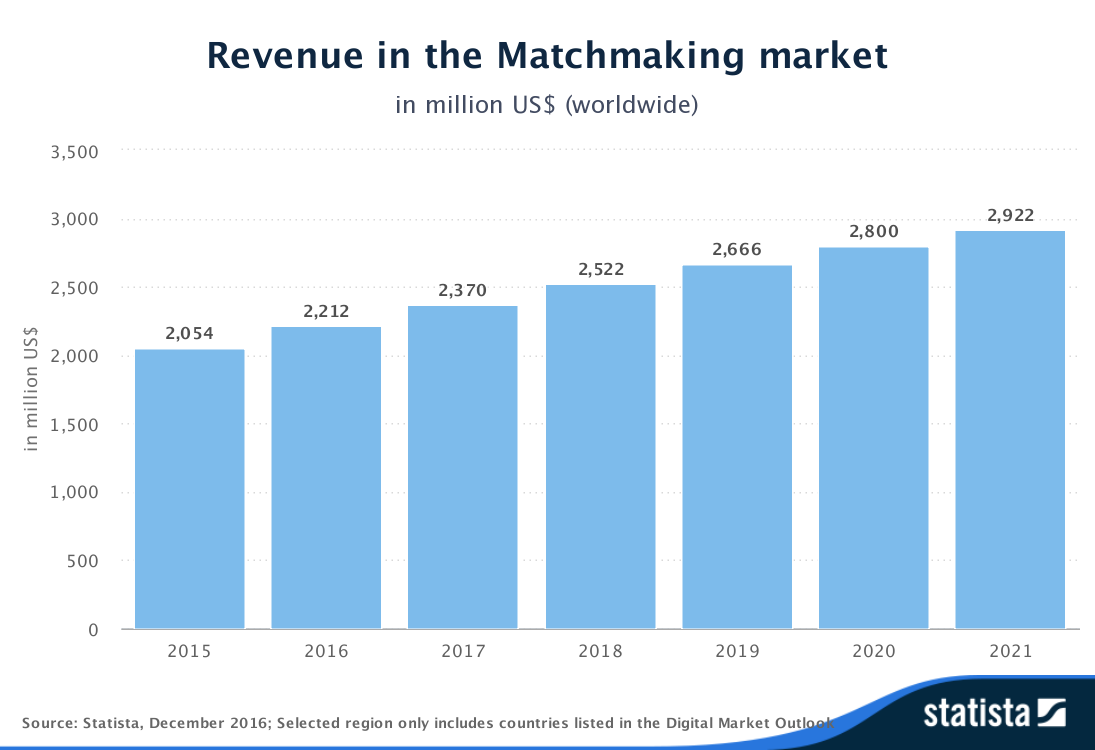
Data from Statista shows global revenue from matchmaking services worldwide. (Courtesy of Statista)
“People are addicted to apps,” said Michelle Frankel, the “Chief Love Officer” of NYCity Matchmaking. Frankel, who charges $300 for an in-person preliminary consultation, said that the endless options offered by apps such as Tinder and Bumble create a “paradox of choice,” rendering users paralyzed. “Because of that, people say they just need to bring it back to the basics.”
Pricey services such as Avgitidis’s and Frankel’s help clients do just this, encouraging them to be honest with themselves about what they want when it comes to a relationship, and sometimes pointing them in a direction that they don’t expect. In her presentation, Avgitidis listed off some of the most common traits that her clients say they are looking for in a partner: “He should be at least 6 feet tall. He must make $250,000. He must have a full head of hair.” Avgitidis said that if you’re looking for a long-term partner though, these qualities are thrown out the window.
“God forbid, if you get sick and have to go to the hospital, do you think any of that shit matters?” Avgitidis said frankly.
“The one thing I’ve learned being a matchmaker — a combination of a recruiter and a therapist — is people want to date themselves,” said Frankel. “Hearing an objective third-party say, ‘You know what, why don’t we try it this way?’ is beneficial.”
Avgitidis and Frankel both have teams of matchmakers and recruiters that scour New York City for eligible bachelors and bachelorettes that they can fix their clients up with. And they encourage their clients to give someone a try, even if they might not be attracted to the person at first, or have a somewhat awkward first date. Matchmaking may be pricey, but it’s not magic. Avgitidis said that she advises her clients to go on four dates with someone before deciding whether or not it’s a good match.
Women in New York face a unique set of challenges when it comes to dating. With four women for every one man, the dating pool is unbalanced, if anything. The city moves fast, too, and some matchmakers say that in a metropolis that’s packed with attractive, successful people, some daters are never satisfied.
Ali Jabon, a retired matchmaker who met her husband through the L.A.-based service Three Day Rule, lives in Los Angeles. She said that both L.A. and New York are particularly hard cities to date in. “We have the entertainment, you guys have finance. But it seems like in both cities, everyone’s looking over their shoulder for the next best thing, and that just makes it so challenging,” she said.
Matchmaking services like Agape and NYCity Matchmaking definitely cater to a particular type of client. Most are in their mid-30 to 50s, and are serious about settling down. Frankel described her business as “very high-end, luxury, hand-holding intimate service.” Caitlin Cooper, who works as a New York matchmaker for Three Day Rule, also said her clients tend to be “higher earners with disposable income, in their prime ages, looking to get married.”
With the high prices and self-described “luxury” services, one might think that matchmakers guarantee success to their clients, or know exactly how to find “the perfect guy” or “the perfect woman” for them. Avgitiditis said that this is a myth: there is no such thing as perfect, only “perfect-ish,” and usually romance-seekers have to be serious about settling down with someone before they accept this. .
“I was definitely guilty of picking people apart. People have too many deal-breakers,” said Ali Jabon, who worked for a pharmaceutical company before having her child, who is two years old. Prior to trying a matchmaker, Jabon had felt pressure from her family, who is Jewish, to find a Jewish man to marry.
The pressure to find someone who can relate to your family is one that Avgitiditis knows well, coming from a Greek background. Her audience related. After she finished her talk, women gathered around her to pick her brain. One woman spoke with Avigitidis about the pitfalls of Greek-American men — “They’re momma’s boys they think they’re God’s gift to the world!”
During her presentation to the Hellenic Professional Women’s Society, Avidgitidis encouraged the women in the audience to look outside of their nationality or religion in order to widen their dating pool. “Greek people and Jewish people do not have a monopoly on strong family values,” she joked. Nevertheless, it seems these Greek ties run deep — both Avgitiditis and her sister, who also works for Agape, married Greek men.
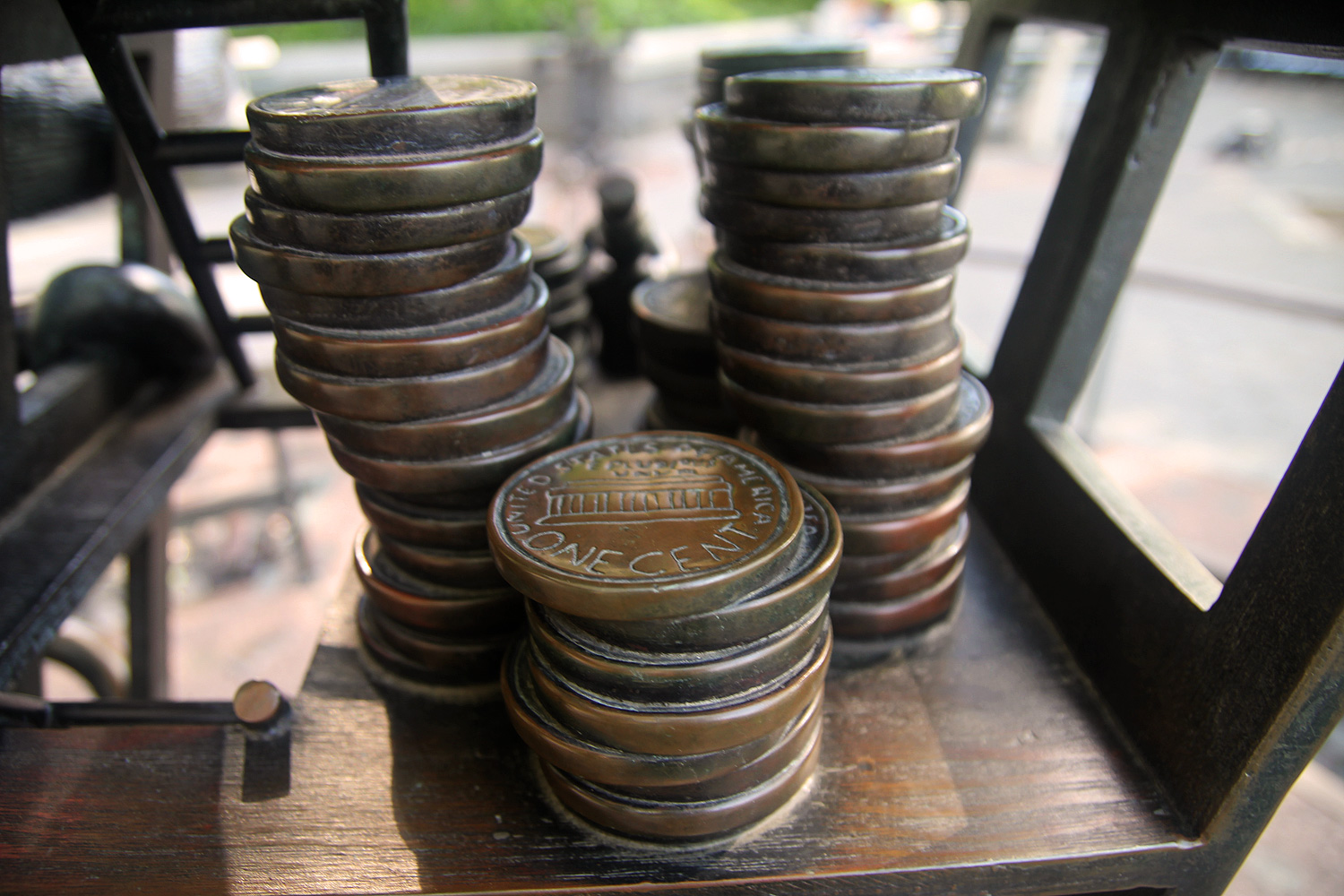
LOOKING FOR A SPOUSE JUST LIKE ME
Arranged marriages are commonplace in some communities, even in NYC
Credit: Projit Bihari Mukharji
by Anya Chapman and Danish Mehboob
Arranging marriages is often seen as an archaic practice that takes place in faraway lands. But they happen in New York City too, one of the most eclectic, and diverse, cities in the world, especially among minority religious groups. Arranged marriages in New York are usually administered with the help of a matchmaker that knows the community well. Here’s how it works in two New York communities.
Muslims meeting Muslims
Jamal Mohsin, founder of Millanus.com, connects Muslims looking for spouses across the United States at bi-annual dating events that take place in New York. Hundreds of twentysomething Muslims, mostly of South Asian descent, participate in Mohsin’s modern-day matchmaking experience, designed and intended specifically for Muslim singles.
“It’s unbelievable how many people show up,” says Mohsin.
Parents of the singles usually attend as well, but they sit separately in the banquet hall.
“Because of our culture, we cannot separate the parents,” says Mohsin about the event. “They can see the interactions between singles, but they cannot hear anything,”
It’s a less expensive and faster way of getting suitors and their families acquainted. Instead of driving or flying miles away to visit a single family, people gather at these matrimonial events to meet five or six matches in a day. It saves time, energy, and money, according Mohsin.
To prepare for an event, Mohsin runs an ad campaign six to eight weeks prior to it. It costs about $6,000 to $8,000 to throw such an event, he says. “It takes a lot of time and effort to put everything together,” says Mohsin. The cost of attendance is about $100 per guest.
Mohsin created his website and the events a decade ago because of a need he saw within the Muslim community. Religious restrictions prevent Muslim youth from attending places like bars and clubs to socialize and mingle, which lowers their chances of meeting someone. On top of that, as Muslims are scattered all over the country, Mohsin says that it’s rare for them to have those opportunities.
“My goal is to help the Muslim community,” says Mohsin.
As a well-connected financial adviser, Mohsin says he has been helping singles from his community find spouses for over 30 years. He helps suitors and their families find their best match based on background including income and education.
Mohsin knows of 38 weddings that took place through his website and matchmaking events last year..
Orthodox Jews meeting Orthodox Jews
Lori Salkin is one of New York’s top matchmakers. She matches Jewish couples as well as advises them through the dating process. Salkin is a senior matchmaker and dating coach at SawYouatSinai.com, which connects Jewish singles worldwide. Most of Salkin’s clients are Jewish-Orthodox, but she also gets clients belonging to other streams of Judaism too.
The site has around 40,000 registered singles to cater to different Jewish populations. There is an $18 per month signup fee for the site, but there is no cost for a matchmaker. It’s a Jewish custom for a matchmaker to volunteer and receive a gift of $2,000 once a couple gets engaged. The customary fee varies, depending on the family’s financial situation and discussions that take place between the couple, the rabbi, and the matchmaker.
She says that parents are also involved. “I would spend half of the day talking to parents – to the mother of a boy, then to the mother of a girl,” she says.
Salkin also carefully studies her clients’ profiles and their family background, which she believes are important in finding the right match. Salkin says she also keeps an eye on her clients’ younger siblings, who may need her help in the future.
Matched Jewish-Orthodox singles normally date for about three months before they get engaged. They typically marry three to four months after that. “There is usually a rush to get married, because the criteria for Jewish-Orthodox singles is so strict and is so hard to fulfill, that you want to lock that match,” Salkin says.
According to Jewish religion every person is supposed to have a soulmate, however the Jewish-Orthodox community is currently experiencing a crisis of not having enough single men and a surplus of single women within their community. Mothers of girls struggle to find spouses for their daughters because of the high female to male ratio within the community. This problem is magnified by the high importance for Orthodox Jews to marry within their own community, as they want to share the same background, values and traditions as their spouses.
“People just want someone who will get their jokes,” says Salkin. Almost 3,000 singles at SawYouatSinai.com found love, she says, resulting in 1,398 marriages.
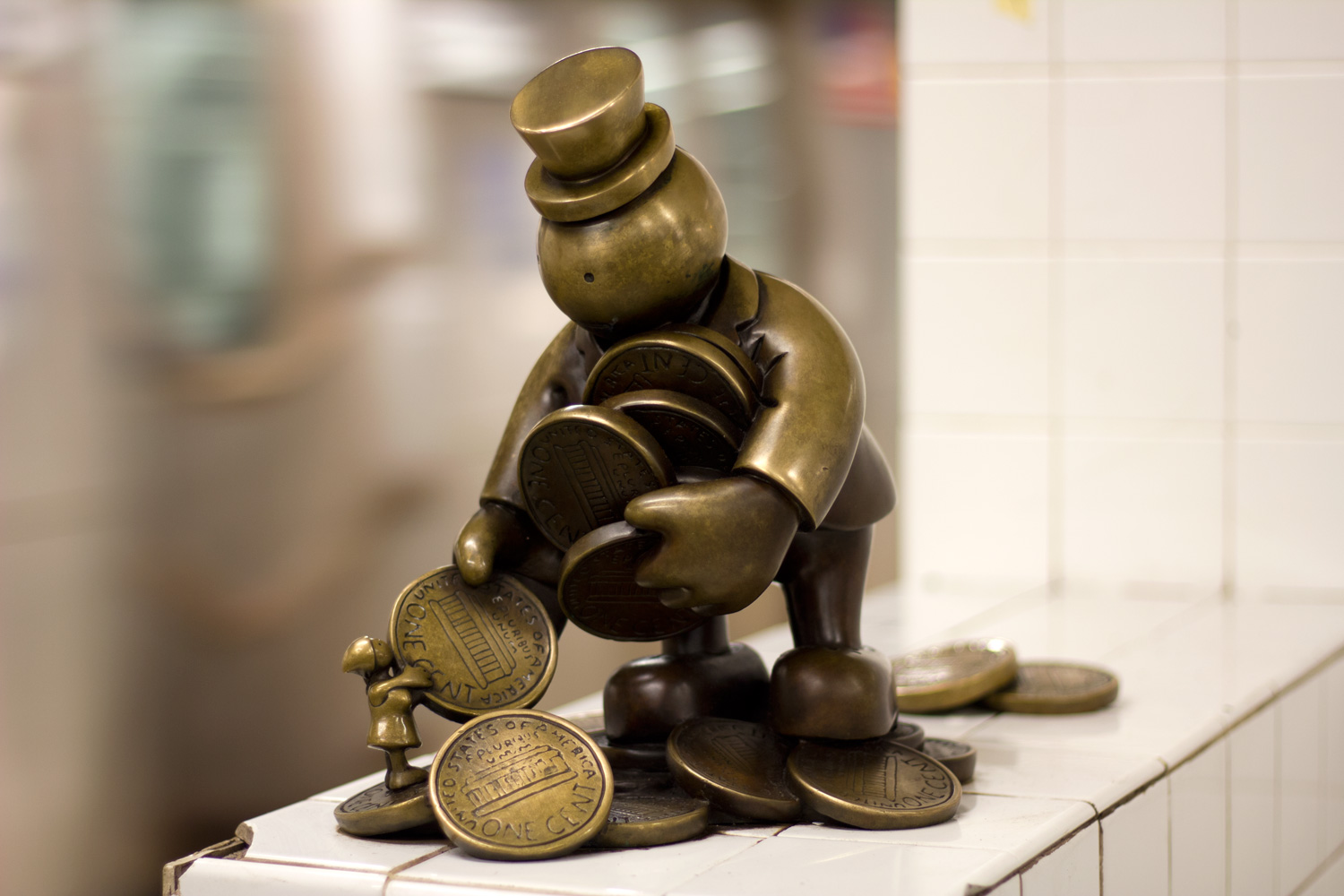
Popping the Question
For couples that want to make a splash, famous settings in the city allow public proposals..for a fee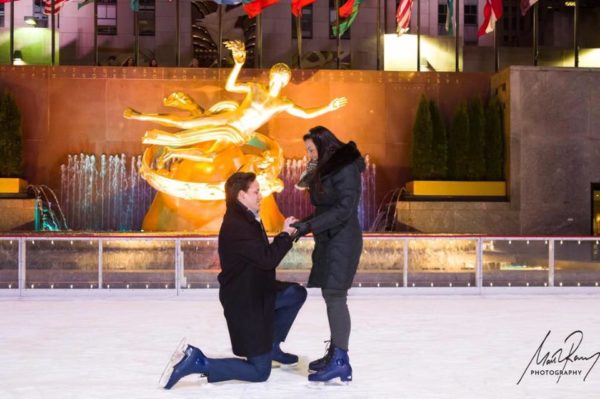
Karl Bauer proposing to his now wife, Elizabeth Plaza, on the ice at Rockefeller Center
by Patrick Ralph
Karl Bauer knows a thing or two about ice rinks. Growing up as a hockey player and fan, Bauer knows how to lace up the skates and glide across the ice. But he never imagined that his love for hockey would eventually lead him to propose to the love of his life on an ice rink too.
“Being comfortable on skates certainly helped with doing that,” said Bauer, 25, laughingly.
This past January, Bauer proposed to his girlfriend of over a year, Elizabeth Plaza, in public on the ice rink at Rockefeller Center in Midtown Manhattan. The rink at Rockefeller Center is one of the many well-known public locations in New York City that offers couples the opportunity to pop the question in a public way. Some even offer marriage proposal packages, which include an assortment of extras from a chance to appear on the big screen at Yankee Stadium to having a saxophonist on the 86th floor of the Empire State Building serenading you and the one you love. From free of charge to upwards of $1,250 proposing at Central Park, the cost of a public marriage proposal package can vary greatly.
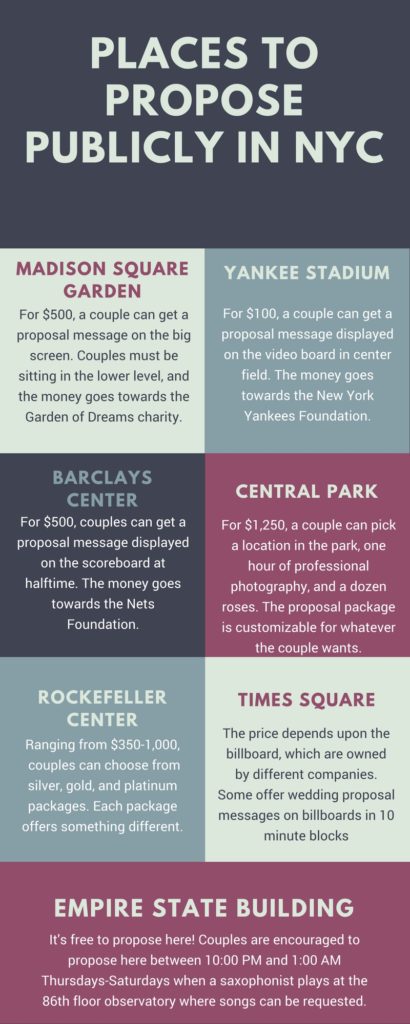
Bauer chose Rockefeller Center’s “Gold” package, which for $500 included special skate passes, exclusive ice time at the end of the session to pop the question, the playing of a song of your choosing, and a champagne toast.
For Bauer, the price tag to propose on the ice rink at Rockefeller Center was inconsequential. “I faintly thought about it, but knowing how much we cared about each other, it didn’t matter,” said Bauer, a research associate who lives in Forest Hills.
Bauer and Plaza met through mutual friends in 2015. Bauer had friends attending Columbia Business School while Plaza was enrolled at Columbia Journalism School. Soon after, the two began dating, and eventually marriage became a topic of conversation between the two of them.
Wanting to do something large and special for a wedding proposal, Bauer booked the ice rink at Rockefeller Center for Friday, Jan. 13, 2017.
“It’s a very romantic and beautiful spot in the city,” said Bauer, who said the Christmas tree was still up on the night of their proposal. “With her being in news, doing the proposal at NBC’s headquarters was pretty special too.”
According to Bauer, he told his girlfriend that they would be going to dinner in Midtown and then over to skate at the ice rink afterwards. While it was a simple cover up, everything went according to plan.
“We had never gone ice skating before and she had no clue we could do a wedding proposal at the rink,” said Bauer.
With a photographer off to the side taking pictures the entire time, the couple skated around the rink. At around 10 p.m., the other skaters got off the ice and the rink was closed off to just Bauer and Plaza. At the center of the ice, Bauer got down on one knee and proposed. Plaza said yes.
“I wasn’t expecting it at all,” said Plaza. According to Plaza, the couple almost didn’t go out to dinner or ice skating that night she because she was feeling sick. But Bauer’s excitement to teach Plaza how to ice skate gave her a reason to tough out her upset stomach and the cold weather.
“It was amazing and perfect,” Plaza said. “I was overwhelmed with happiness. That’s the meaning of true love.”
The couple celebrated afterwards with music and a champagne toast on the ice. Although marriage had come up before in previous conversations, Bauer said that he was glad that Plaza was caught off guard by the proposal.
“She was surprised,” Bauer said. “It was a special moment for us to have in front of all these people.”
In February, Bauer and Plaza officially got married at City Hall, but the couple will be having a larger wedding celebration in Plaza’s home country of Ecuador in July 2018.
Bauer admits his proposal proved to be an unforgettable one for him and his fiancé, but his advice for other men planning public wedding proposals is to go for what fits, and not necessarily for the proposal that will make a big splash.
“It should be something based on the girl’s personality,” Bauer said. “If you’re going to propose to her and spend the rest of your life with her, you should know what she wants and what she would like. Proposing in public in front of other people isn’t for everyone.”
For Bauer, he knew that this is what his girlfriend wanted. “Based on her personality, a grand proposal in New York City would be something memorable and I knew she would like it,” said Bauer.
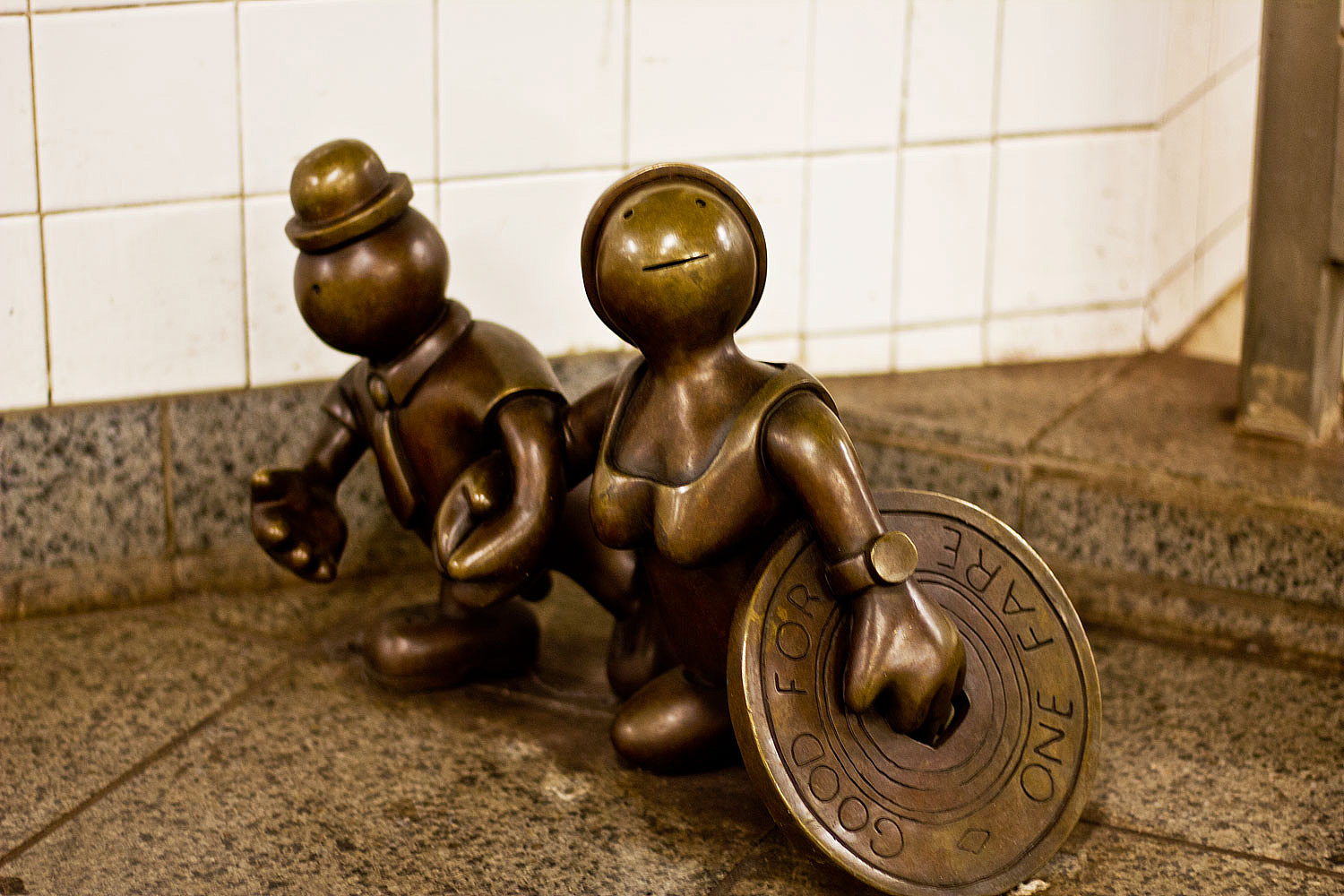
Finding love over 50
Seniors given second shot at companionship with new appby Katryna Perera
Paulette Mann sits in a chair with her legs crossed casually outside a bar on a sunny day on the Upper East Side. She wears big, square-shaped sunglasses and scrolls through her phone with glitter painted nails. If it weren’t for the wrinkles on her face, a passerby would never guess she is 82-years-old.
“I’m a 15-year-old living in an 82-year-old’s body,” she said.
And just like the typical young person of today, Mann is looking for love – on a dating app. She is one of many in New York City on Stitch, a dating and companionship app and website designed specifically for people over 50.
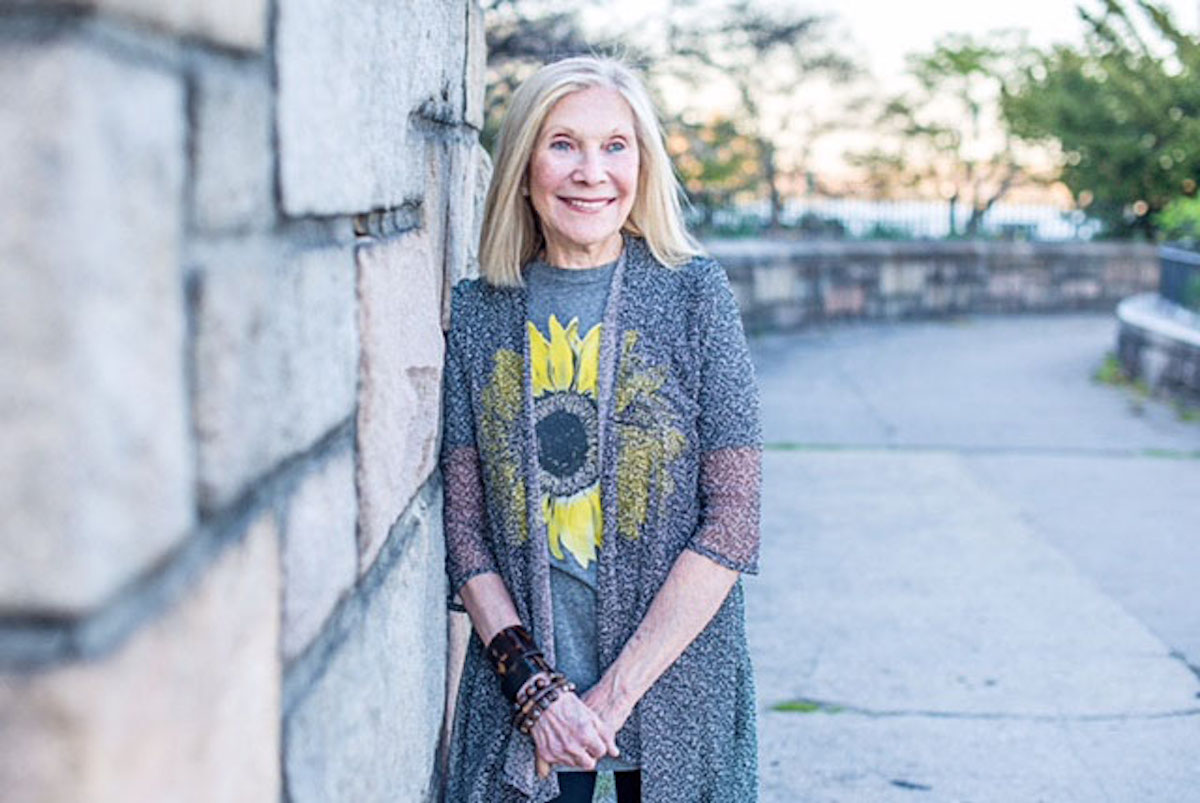
Paulette Mann, 82, is an active member on Stitch, an app and website designed specifically for people over 50 who are looking for love and friendship. (Photo courtesy of Paulette Mann.)
Stitch’s founder and CEO, Andrew Dowling, thought of the idea for Stitch through a previous business he ran that helped older communities get online.
“We discovered that as people get older they get lonelier,” said Dowling. “Your social circle inevitably shrinks [and is] not automatically replenished.”
Stitch, according to Dowling, was launched with a social mission in mind: to help older people find companionship because social isolation is prevalent among older age groups and can sometimes even be more life-threatening than physical impairments.
Many people join Stitch because they’re lonely—either their partner has passed away or they cannot participate in thactivities they once loved. Dowling said many people also join Stitch because they recently entered retirement and want to enjoy it with someone.
“They were holding off and sacrificing for all these years and then they get [to retirement] and there all these things they wanted to do but they don’t have anyone to do them with,” said Dowling.
And according to statistics, older people also seem to crave some form of companionship. According to a New York Time’s article published in 2014, the over 60 crowd was the “fastest growing segment in online daters.”
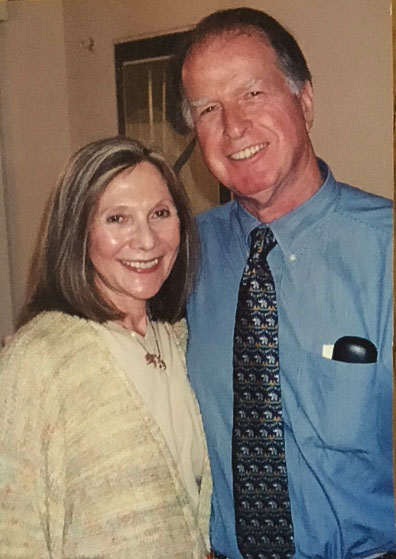
Mann and her husband were married for almost 50 years when he died unexpectedly to leukemia. (Photo courtesy of Paulette Mann.)
Stitch currently has over 65,000 registered users. The average age of a Stitch user is in his or her mid-60’s said Dowling, and the 50-year minimum age requirement is very strict. Dowling said the reason for it is so they can avoid scammers and “gold-diggers.”
Users can join under a monthly or annual membership plan and there are different levels of access. Members can pay either $19 a month or $108 a year in order to only browse through other member profiles. For full access to the Stitch community as well as unlimited profile browsing privileges, the price is $24 a month, or $120 a year.
Dowling said Stitch can also be used for free, but the access is very limited.
The reason for the monthly versus annual option is because many people come to Stitch thinking they just want to try it for a month and see what it’s like first, said Dowling. But then many discover that this is a community they want to join.
As for Mann, the 82-year-old with the glittery nails, she locked on to Stitch after her husband passed away unexpectedly 12 years ago from leukemia.
“He died in a week,” said Mann. “I couldn’t even breathe.”
Originally from New Jersey, Mann decided she needed a change of scenery, so she packed up and moved in with her son and his family, who live in Manhattan. After 18 months, she found her own apartment and has been living by herself ever since.
But there was something still missing.
“There was a tremendous void in my life,” said Mann. “To me, the greatest joy in life is being in love with a man that loves you back and having that friendship and intimacy and I didn’t have that.”
She decided that she needed to be proactive and joined multiple dating sites including Tinder, OkCupid, and eHarmony.
But she wasn’t ready to go all-in, so she set up her profile as a 99-year-old widow. She knew that not many people would initiate conversation with her as a listed 99-year-old and she wanted to browse and see what kind of men were out there. She asked one question of every man, who was also a widower, that she matched with: “When did you want to live, laugh and love again?”
“I wanted to get some faith back that not every man wants to date a month after his wife dies,” said Mann.
The regular dating apps proved to not work for her though, especially Tinder. Mann said there she would continually run into catfishers and scammers and the men were not what she was looking for.
“I got off Tinder because it got to be depressing,” she said. “You’re looking for a king or a prince and it’s a deck of jokers.”
She read about Stitch in a magazine one day, decided to try it out, and it clicked.
“It’s a dating site with integrity,” said Mann. “The concept is so different because it’s not just a dating site.”
Which is true. The company is designed to help people find both love and friendship.
“As we get older, a lot of people come to the realization that life and human connection is about so much more than just having that one person,” said Dowling.
Mann also loved the thorough vetting process of Stitch. When new members join Stitch, they must verify their accounts through a technology that takes a webcam photo of the member and another photo of their ID or passport and conducts a face-match verification.
Since scammers tend to target older groups, Dowling said keeping their members safe is one of their top priorities.
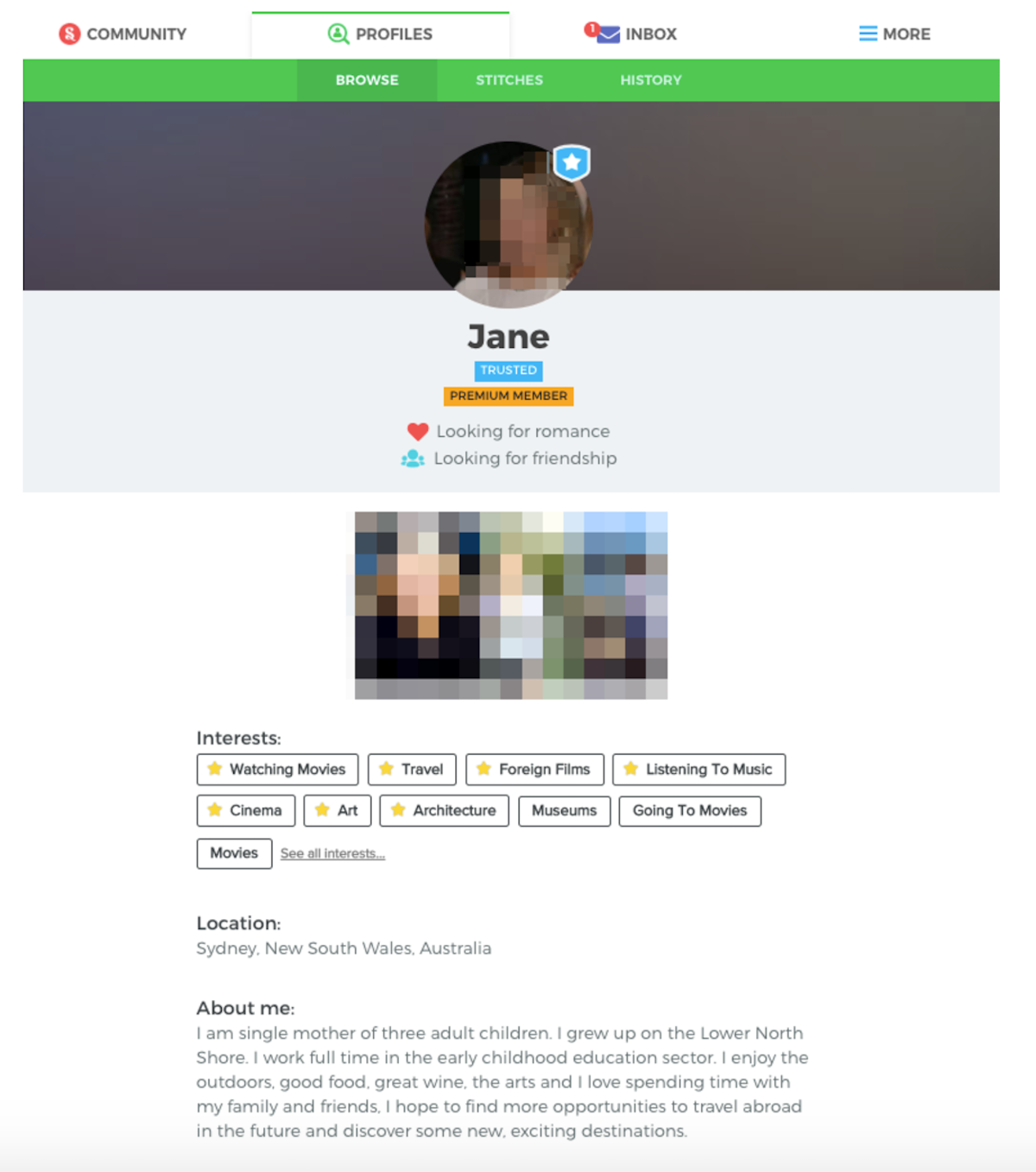
Stitch allows users to browse through profiles and participate in community activities with other members. (Photo courtesy of Stitch.)
Mann has now been a member of Stitch for three years. She has matched with a few eligible bachelors, but so far none have stuck. She’s not worried or disappointed because she is set on what she wants in a companion.
“They have to have a strong sense of self and humor. I’m not looking for money,” she says. “I don’t want to be a nurse or a purse for anybody.”
Mann thinks she has yet to connect with somebody because she lives in New York City and her age demographic. She claims many older men feel insecure about their age and are hesitant to go out and meet others because they’re afraid they won’t have enough energy to keep up with anyone they meet.
Although Mann has not found love on the site yet she did find her niche within the Stitch community as a “community champion,” what the site calls users who understand the value and missions of Stitch and who help other users get the most out of their experience.
Because Mann doesn’t like dating that much, being a community champion has allowed her to do what she loves—planning events and connecting people—while also searching, every once in a while, for a new love.
“I have not given up hope,” said Mann. “Because if I give up hope, I give up living.”

ADVENTURES IN TINDER-LAND
How a reporter unexpectedly found love in the app dating worldby Belen Smole
What are the odds of finding someone worthy in Tinder? Probably not high, but not impossible either.
As for many people there, Tinder was my escape to the dramatic end to a relationship with the man I thought was the one. By September 2014, I was in College Station, Texas, visiting an old friend. I thought it was going to be a girl only trip, but I found myself hanging out with my friend and her boyfriend all the time. So I ventured into the world of “tindering” (Tin-der-ing, which according to the Urban Dictionary, means “looking for a date”).
I come from Buenos Aires, the cosmopolitan capital of Argentina, so “tindering” in Texas for me was an experience itself. Guns, guns, and more guns. Hunters, fishermen, men posing with dead lions and showing off huge rifles. The shock I first felt became a game of curiosity, a kind of hobby, a way to kill time while my girlfriend drove us from Houston to San Antonio and back to College Station, where she attended the University of Texas. She was petrified by the idea of me being on Tinder. She’d never seen it before and to her understanding, a strong just converted Baptist, this was like playing with the devil.
Left, left, left. All swipes to the left, they all seemed crazy to me. But one really got my attention. His profile picture showed a tall, slim, brunette and light blue-eyed guy wearing a gray shirt and a black tie. The smile of a good boy and a funny quote in his bio: “Olly, olly, oxen free.” He passed the test and that was an instant match. He had liked me back. That was Sept. 27, 2014.
We started talking over the Tinder chat app. He was a financial analyst from Nashville, Tennessee, who after growing tired of the financial world, he quit and went back to school to become an unexploded ordnance technician, someone who locates and discards ammunitions of all kinds. Far away from putting him in my throw away basket for the gunmen, the idea of him dealing with bombs for a good cause got my attention. His job was basically to look for unexploded bombs from the Second World War or military bases, to avoid any accidental explosions years later. As a journalist, curiosity and reporting always gets my adrenaline going and a good story always makes my heart pump. And this one had potential.
He discovered I was from Argentina. He was a soccer player, so soccer became an instant topic of conversation and connection. We would talk until late at night about soccer legends Lionel Messi, Diego Maradona and Carlos Tevez. We hit it off immediately, but unfortunately, we were running out of time. I was leaving in a couple of days for a wedding in New Orleans. And it was unlikely I would ever come back to Texas again.
“I wouldn’t do this so suddenly but being 50 hours a week around men, there’s nothing I’d like more than to take a pretty girl out for dinner,” he finally said. And I was all in. We arranged to meet the next Tuesday. But Tuesday came and I got cold feet. “Who was this guy really? What if he’s one of these psychopaths we see on TV every day? Where’s he going to take me? I don’t know the city; I know nothing about him and this place.” All these thoughts went through my head. He messaged, but I never replied.
He texted again the day before I was to leave Texas saying that he wouldn’t have expected an Argentinan girl to stand him up. He added he always wanted to go backpacking in South America and asked if was it ok to remain in touch. Sure, I thought, what harm could come of that. So I gave him my Facebook handle, figuring we’d never talk again.
But we did. We started on Facebook. I’m not sure how long it took before that happened. He’d find the most ridiculous excuses to talk, and I liked it. “I know you are good with photography, I want to give my dad a camera as a Christmas gift. Would you recommend one?” he asked once. Later, I found out his dad barely knows how to use the camera on his iPhone.
By Christmas break of 2014, we were talking every single night on Facebook messenger. We’d talk about relationships, goals, family, dreams. I’d wait for his reply every day, all day. Even though I’d never heard his voice, I fell for this southern guy.
On May 11, 2015, I finally heard his voice for the first time. I wanted that as a birthday gift from him, and he had agreed. He sent me a voice note over Whatsapp, and at that point I knew I fell in love with a man that I did not know physically, but whose soul I knew from the deepest part of my heart.
Long story short, we talked like that for 16 months. We shared pictures of our friends, our dogs, our families, and ourselves. But we still hadn’t met: He was in Guam working as a bomb technician, and I was sitting for exams to get into the Columbia Journalism School.
Sixteen months after that first Tinder match, on January 25, he caught a 22-hour flight to Buenos Aires. I waited in the airport to greet him. It was probably the most anxious and nervous I have ever been in my life. To make things worse, as I waited at the gate, a production crew from a national TV show approached me and asked me what I was doing there. I told them, they loved it and they immediately asked if they could put us on camera.
As a journalist who often gets a homicidal instinct when people don’t want to talk to me on camera, I agreed. After all, it wouldn’t hurt to have our first meeting after 16 months of texting each other recorded. The “episode” aired that same Sunday and went viral.
People underestimated the relationship at first because of the way we met. We didn’t know why we were on Tinder, but we both were sure, it wasn’t for a one-night stand. Maybe it was fate; maybe it just had to be that way. As corny as it might sound, we now both agree that our connection is so strong, because we got to know each other’s minds and hearts before we knew each other physically.
We’ve never looked back. We fell in love over the Internet; we confirmed it with that hug in the middle of a crowded terminal in Buenos Aires International Airport. And we wouldn’t have had it any other way.
